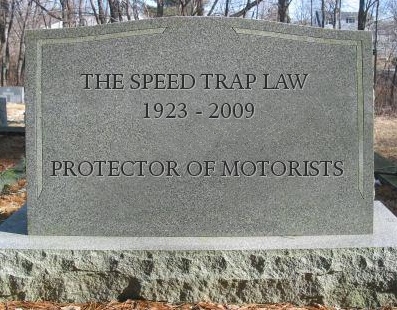If you haven't already done so, please read the Home
Page
Opposing
AB 5 6 4
(AB
5 6 4 Guts the Speed Trap Law)
This Page
Updated 6-26-09
[AB 564 failed to pass.
Highwayrobbery.net provided the info below during early 2009, when the
bill was under active consideration.]
Don't let this
happen:

Ask your state senator to keep the Speed Trap Law alive.
A B 5 6 4: Potential Vote on June 30 or July 7 [The Bill Failed]
On Monday May 18, the bill was approved in the Assembly, and then moved over to the Senate for further action. The May 18 vote was mostly along party lines - only three Democrats voted "no." This voting along party lines suggests that most of the assemblymembers hadn't given much thought to the bill - they voted how their party told them to. It is our job to get our legislators to vote how the people they represent tell them to, not how the party dictates.
Now that the bill is in the Senate, the first possible vote will be in the Senate Transportation Committee, on June 30. Please phone your state senator (especially those on the Committee) and ask him or her to vote "no" on A B 5 6 4. (Phoning is more effective than emailing, and I recommend calling their Sacramento office, not their local one.)
[On June 23 the author withdrew AB 564 from consideration, and on June 26 he completely re-wrote it to be a bill controlling the earnings of drug treatment center employees.]
If you're not sure who your senator is, you can get their name and phone number at this official site: http://www.leginfo.ca.gov/yourleg.html
A list of all senators is here:
http://www.leginfo.ca.gov/sen-addresses.html
Please call the governor, too. (916) 445-2841
Click on this highwayrobbery.net link for more info about phoning, and the other new bills (which are stalled).
|
A B 5 6 4 Explained
 AB 5 6 4 Author Assemblymember Anthony Portantino Right now, nearly all cities publish a "circulation" map on which they apply one of three designations to each of the streets in town: arterial, collector, or local. A city can collect Federal Aid to Urban Highways money to help maintain the arterials and collectors - but not for the streets it has mapped as "local." Considering that it cannot receive Federal Aid money for a local street, why then would a city map any of its streets as "local?" Why not call all the streets - even the little ones - "collector?" The problem is that along with the collector designation comes the present Speed Trap Law requirement that on a collector (or arterial) street, if speed is enforced using radar, the posted speed must be based upon an engineering survey of actual speeds driven. If a city has a collector street where actual speeds are on the high side and the neighborhood is complaining, right now it has two choices. Choice 1: The city can continue to map the street
as a "collector." With
that designation, the city will receive
Federal Aid to Urban Highways money for maintenance of the street - but
will also have to abide by the Speed Trap Law, and as a result will
have difficulty
reducing the posted speed much below the speed actually driven by the
majority of motorists using the street. Choice 2: The city can re-map the street as a "local" street. It will no longer be able to collect the Federal money, but it will be able to set a 25 mph speed limit without regard to the actual speeds driven by the majority of drivers, and can enforce that limit with radar - because the Speed Trap Law does not apply to local streets.
The Speed Trap Law began in
1923. Its whole purpose is so that you or
I can venture into any California city and know that if we drive the
same careful and courteous way we would in our own neighborhood back
home, we will
not get a ticket. If A B 5 6 4
passes, one* town, Pasadena, will be
allowed to make its own
special rules, rules that the average visitor will not know about until
he comes to Pasadena and receives a ticket. In other words, the
city
will be allowed to operate speed traps. (*And it will not stop with
Pasadena - once Pasadena is permitted to make its own rules, there will
be lots of other
cities wishing to do the same.) "By
redefining the definition of 'local streets and roads,' under this
bill, it is possible that unrealistic posted speed limits would be
established without any regard to prevailing speeds (85th percentile)
or traffic characteristics of the roadway. This could result in
'speed
traps' and speeding citations for the
overwhelming majority of drivers
that are driving these roads in a prudent and safe manner
causing no
undue speed-related traffic hazards." (Official Bill
Analysis of 5-15-09, emphasis added. Available at the official
website for the bill.)
The
legislative analysis lists the AAA Auto Club and the Teamsters as
opposing AB 5 6 4. The bill is also opposed by the
National Motorists Association . "3. Problem of perception, creating a speed trap. When asked if there were a safety issue associated with speed on these streets, the City of Pasadena was not able to provide evidence that there was a higher collision rate, or any other type of incident that would indicate a safety problem, on what would be "local" roads under this bill relative to local roads defined in the traditional manner. It appears that the residents simply prefer a lower posted speed limit. Posting a lower speed limit, however, is not likely to slow traffic down. The 85th percentile has long been used as the standard for setting speed limits because experience has shown that the majority of people drive at a speed that feels safe for the conditions. If the conditions do not change on the roadway, drivers will continue to drive at their current speed. Because this bill allows for radar enforcement on segments that were not justified on the grounds of an ETS [engineering and traffic survey], this situation will likely cause more motorists to be cited for speeding. The committee may wish to consider whether it is appropriate to create what could be, in effect if not in statute, a speed trap for the residents of the City of Pasadena." (Analysis of 6-18-09, emphasis added.) ****
|
Here is the breakdown of the May 18 vote (from the Assembly's official website for the bill) - so that you can tell how each party voted, highwayrobbery.net has put the Republicans' names in bold:
UNOFFICIAL BALLOT |
---------------------------------
RED LIGHT CAMS
www.highwayrobbery.net
www.highwayrobbery.net